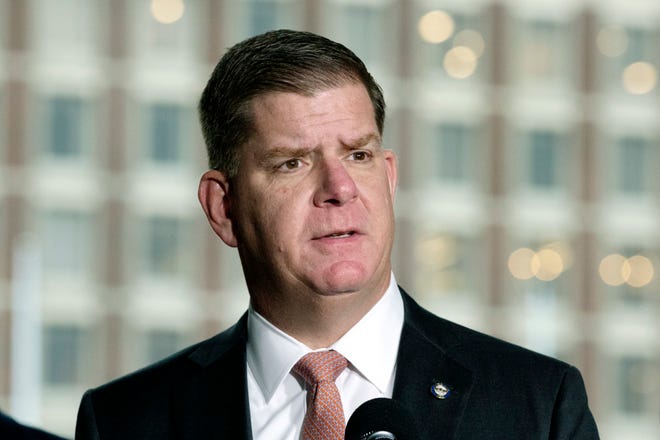‘Great Resignation’ resolution? Create better jobs, Labor chief says
Written by ABC Audio All Rights Reserved on February 12, 2022


Labor Secretary Marty Walsh says he has a simple remedy for both the record job-quitting and severe worker shortages upending the U.S. economy.
Create better jobs.
“There’s been a lot of talk about the so-called ‘Great Resignation’. That’s not the real story,” Walsh said Friday at at the U.S. Conference of Mayors’ winter meeting in Washington, D.C. “The truth is workers between the ages of 25 and 54 are returning to the labor force at a higher rate than in previous recoveries. America is back to work.”
Workers, he says, just need better jobs – with higher pay, better benefits, safe working conditions, training opportunities, predictable hours and more – to draw them into the market. And, he says, the Labor Department can help pave the way for those things.
Walsh, of course, is right – at least partly. Prime-age workers did return to the labor force last year at the fastest clip in recent memory. The share of people age 25 to 54 who are working or looking for jobs rose to 81.9% in December, up from 81% a year earlier.
But that’s still well below the prepandemic mark of 83%.
MANAGE YOUR FINANCES LIKE A PRO: Sign up for USA TODAY’s free newsletter, The Daily Money

COVID-19 created so much economic upheaval that much of it is being repaired even while big gaps remain. For example, the U.S. has recouped 18.8 million, or 84%, of the 22.4 million jobs lost early in the pandemic. But that still leaves the nation 3.6 million jobs shy of its pre-crisis level.
Nearly 6 million Americans have returned to the labor force since April 2020 but that means the total supply is still 2.3 million workers below the pre-COVID high.
Broadly, however, Walsh is pushing back at the belief some may people harbor that workers are simply quitting jobs en masse and don’t want to work, leaving the U.S. with its most dire worker shortage in decades – a deficit that’s curtailing economic growth.
“The data shows that workers are resigning to take new – and often better-paying jobs,” Walsh said. “Workers are seeking better opportunities in ways we haven’t seen in decades. They are looking for opportunities to learn the skills they need. They want a seat at the table. They are demanding better pay, safer working conditions, more benefits and flexibility.”
In an interview, Walsh added, “Americans want to work – but it’s not enough to just bring more people into the workforce. We must ensure the jobs that workers access provide more than a paycheck – good benefits, safe workplaces and a pathway to the middle class.”
Labor force may remain smaller
Millions of Americans remain outside the labor force a variety of reasons, including COVID fears, the lack of affordable child care, career changes, decisions to become entrepreneurs and early retirement. While many are expected to stream back in this year as the pandemic fades and more people are vaccinated, others, such as most early retirees, won’t ever come back, economists say.
The labor force participation rate – the share of adults working or job-hunting – is expected to rise from 61.9% to 62.8% by the end of this year but will likely never reclaim its pre-COVID level of 63.4%, according to Mark Zandi, chief economist of Moody’s Analytics.
PRESSING AHEAD OR PAUSING?Companies from Starbucks to Carharrt navigate how hard to push vaccines after SCOTUS blocks mandate
As a result, employers are struggling to hire as never before, prompting them to sharply raise pay and beef up benefits. In November, employers posted a near-record 10.6 million job openings and a record 4.5 million workers quit, typically to take higher-paying positions. Some, however, simply bolted, figuring the job market is so good they’ll be able to find another position, often in another field.
Twenty percent of workers surveyed by Joblist last year quit to pursue new career paths, a transition that may take time as employees learn new skills and leaves them on the sidelines for months. For example, many restaurant and retail workers have grown weary of the low pay and health risks that come with their jobs and are shifting to technology or warehouse jobs. More than half of last year’s job switchers changed industries, according to LinkedIn.
Walsh believes that at a significant part of the labor shortages can be addressed if all employers provide well-paying jobs with robust benefits. And the Labor Department, he says, can help.
On Friday, Walsh unveiled a “good jobs initiative.” As President Joe Biden’s administration rolls out its $1 trillion infrastructure plan, passed by Congress in November, Walsh says Labor will work with other federal agencies and federal contractors to ensure the millions of jobs created will be “good jobs.”
DIVERSITY CHECK:We asked Walmart, Amazon and others about hiring for diversity. What we found may surprise you
That means good pay, a safe working environment, training opportunities, predictable schedules, the ability to join a union and freedom from racial, gender, age or other discrimination as required by existing laws, Walsh says. He also wants to make it easy for workers to learn their rights by providing such information online, he says.
Labor, he adds, wants to extend that “template” to interested states and cities and even the private sector, though he says the details of how that will happen are still being ironed out. Biden’s Build Back Better social spending bill would mandate paid family leave and provide billions of dollars to subsidize child care but the chances of passage appear slim amid opposition from Democratic senators Joe Manchin of West Virginia and Krysten Sinema of Arizona.
“In the last 50 years, an inequity has grown in our society from when we used to have a strong middle class to a kind of upper class with a little bit of a middle class and pretty much everyone else,” Walsh said in the interview. “We want to change that scenario.”
The post ‘Great Resignation’ resolution? Create better jobs, Labor chief says appeared first on Correct Success.

![Download your Women of Color Expo Seminar Schedule here! [FREE TO ATTEND] Download your Women of Color Expo Seminar Schedule here! [FREE TO ATTEND]](https://kvsp.com/wp-content/uploads/2024/04/businesswoman-making-presentation-at-conference-2023-11-27-05-15-58-utc-1024x683.jpg)





